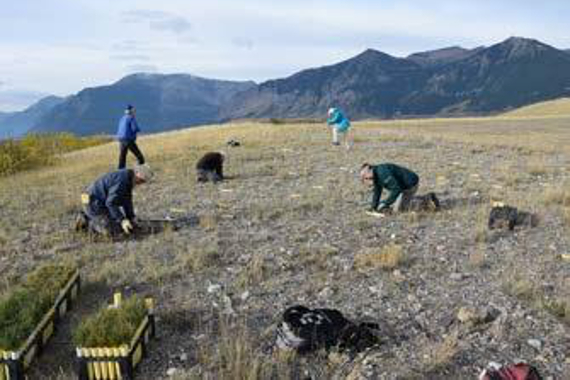
Rescue the fescue
Restoring grasslands in Waterton Lakes National Park
What’s the issue?

The health of the grasslands in Waterton Lakes National Park has been declining since the late 19th century. Roughly 25 percent of grasslands in the lowest elevations have been colonized by shrubs and aspen forest since 1889. The main causes are a lack of fire and grazing bison; an increase in invasive plants has also taken place. Today, 10 percent of Waterton’s estimated 1,100 plant species are nonnative, and many of these are harmful to grassland health and biodiversity. Representative of the ailing grassland is the status of the northern leopard frog. Threatened in Alberta, northern leopard frogs form important links between wetland and grassland habitats, moving between the two for reproduction and feeding. On the decline since the 1970s, they disappeared from the park in 1980.
What’s our approach?
- Reverse the declining trend of the park’s grasslands by 2019.
- Remove priority invasive plants, like spotted knapweed, and re-vegetate disturbed sites with native plants grown from locally collected seeds.
- Restore prescribed fire as a process on the landscape to reduce tree and shrub encroachment.
- Re-establish northern leopard frog by transferring eggs from healthy populations in Grasslands National Park.
- Engage Canadians through outreach, interpretation, education and volunteer opportunities.
What’s been accomplished?
- Developed and implemented an invasive plant-management system.
- Controlled invasive plants on 1,327 hectares of grassland habitat.
- Collected seeds from 48 native grass and wildflower species, and planted 5,500 plugs on 2 hectares of disturbed grassland; established a climatecontrolled native plant seed storage facility to support restoration work.
- Used prescribed fire to reduce tree and shrub encroachment in 1,571 hectares of grassland, and used satellite and drone imagery to monitor results.
- Recorded northern leopard frog breeding in the park for the first time since the 1970s.
- Engaged more than 200,000 Canadians in grassland conservation and restoration learning, and volunteer opportunities such as our award-winning Ecosystem Investigator Camp.
Related links
- Igniting restoration
- Two pines in decline
- Conserving an alpine enigma
- Historic homecoming
- Wildlife crossings
- Going with the flow
- Propagating success
- Listening to the sea, looking to the future
- Ecosystem on the edge
- Keeping dunes dynamic
- Wild about wolves
- Restoring kelp in Gwaii Haanas National Marine Conservation...
- Llgaay gwii sdiihlda, or restoring balance
- Date modified :